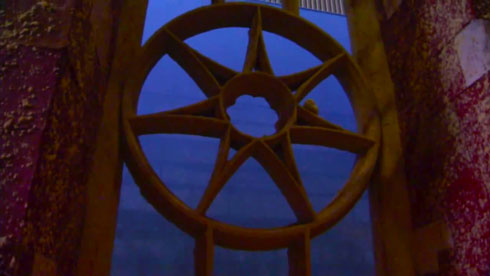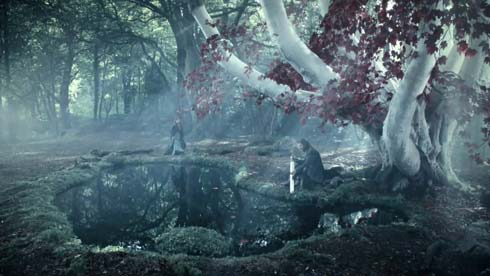“Swear it,” Arya said. “Swear it by the gods.”
“By all the gods of sea and air, and even him of fire, I swear it.” He placed a hand in the mouth of the weirwood. “By the seven new gods and the old gods beyond count, I swear it.”—George R.R. Martin, A Clash of Kings
The setting of A Song of Ice and Fire is one where there are many faiths, and many faithful. People who don’t believe in any gods at all are quite rare, when compared to the great majority that do. To begin with, however, the faiths of characters are largely a background detail, an added piece of verisimilitude. It’s only in the later novels that Martin reveals that religion, and religious faith, is playing an important role in the larger story. That story extends beyond the political realm of the primary conflicts of most of the books, and into the more epic, Manichean struggle against the Others that’s likely to increasingly occupy a central place in the series.
But where do all the gods stand? And how many are there?
Westeros has relatively few significant religions, briefly described below:
There are no priests, no holy texts, no songs of worship, and practically no rites that go with the worship of the old gods. It’s a folk-religion, passed from generation to generation. The closest thing to a ritual we’ve seen is prayer before the heart tree in a godswood, holy groves contained within castles throughout the Seven Kingdoms, and often the only places where living weirwoods still remain until one goes north of the Wall. It’s said that the sigh of the wind and the rustle of leaves are the old gods speaking back to worshippers.
Notable followers of the old gods: Lord Eddard Stark, Jon Snow, most
Northern lords, Lord Tytos Blackwood.

The whole symbology of the Faith is tied up in the number seven: the seven colors of the rainbow (which leads to the use of faceted crystals to break up light into its constituent colors), for example, and the seven knights of the Kingsguard are another example. The Seven-Pointed Star is the chief holy text, but there is devotional literature of various sorts. Up through the reign of Jaehaerys the Conciliator, the Faith was a genuine power in Westeros, but with his predecessor Maegor’s brutal oppression of the orders of the Faith Militant and Jaehaerys’s promises to defend the Faith, the High Septon has up to recently been more a figure head than a political power, although there have been exceptions.
Notable followers of the Seven: Catelyn Stark, Ser Barristan Selmy, Brienne of Tarth, most lords south of the Neck.
Like the followers of the old gods, the Drowned God’s worshippers have no real organization. Unlike them, however, there are priests and certain rites. The priests of the Drowned God appear to receive the calling and simply declare themselves priests, and it’s up to their conduct to prove that they bring the Drowned God’s holy word to the faithful. The biggest test is the drowning, an extreme baptismal rite in which someone is literally drowned, only to be resuscitated (with a primitive sort of CPR); it’s a particularly holy priest who always gets a drowned man breathing again.
Notable followers of the Drowned God: The Greyjoys of Pyke, Lords of the Iron Island. Most notably, Aeron Damphair, a noted priest of the Drowned God.
Mother Rhoyne is the focus of their faith, but their religion contains lesser deities, many who are river-dwelling animals such as the Old Man of the River, a turtle-god. Their level of organization and even whether there is a priesthood is unclear.
Notable followers of Mother Rhoyne: Garin.
Westeros isn’t the only place where religion matters, however. On the other side of the narrow sea, it seems there are as many gods as there are peoples. At least a dozen separate gods have been mentioned. Among them are the Weeping Woman (a favorite of old women), the Lion of Night (preferred by rich men), the Hooded Wayfarer (a patron of the poor), Bakkalon the Pale Child (favored of soliders…and a reference to Martin’s Thousand Worlds setting, where the militant cult called the Steel Angels worship him; they’re featured in “And Seven Times Never Kill Man”), the Moon-Pale Maiden and the Merling King (favorites of sailors), and the Graces (worshipped in Slaver’s Bay). In Braavos, where there are temples and shrines to almost every god one can imagine (a detail which reminds us of Leiber’s Lankhmar, with its many rival preachers), there’s a temple to the Many-Faced God, believed to be the true face of all the gods.
But one religion appears, quite early on, to have particular importance: the worship of R’hllor. “Him of fire,” as noted above, the R’hllorians seem as organized as the Faith, with priests and priestesses at great temples in Pentos, Volantis, and elsewhere, including a small temple in Oldtown for the sailors who believe in him. R’hllorians keep nightfires burning to keep the Great Other at bay, praying for the return of another victory in the great struggle so that the sun can rise again. “The night is dark and full of terror,” is part of their catechism. Perhaps the most interesting aspect of their faith is that they proselytize, which is the reason why Thoros of Myr—the debauched, jolly warrior-priest with a penchant for using wildfire to set his sword alight—has been at King Robert’s court, attempting to convert the king (without much success, and with little sign that he’s made any serious effort).
The other aspect is that the R’hllorians, unlike most other faiths we’ve heard of, seem to actually practice sorcery as part of their faith. This seems largely limited to prophecy, which they do by looking into flames and seeing the shape of what may be. It’s a valuable gift, but a dangerous one, as all sorcery is. But Westeros is a world where magic is growing more evident and more powerful after a long decline, and that increases both the value and the danger of the magic performed. A red priest who could only see fitfully in the flames may now seem much more, and other abilities related to the conjuring and use of fire may manifest itself. Even the great god’s own kiss, a rite in which a priest breathes in flame and then breathes it into the mouth of the faithful dead, may have unexpected consequences….
Notable followers of the R’hllor: Melisandre of Asshai, Selyse Baratheon, Thoros of Myr, and the Brotherhood without Banners.
The general arc of the series has been one towards the increasing importance of magic. It’s also pushing towards the increasing role of religion, as the wider conflict becomes increasingly in focus. Whether this role will be primarily a political one or one focused on their interaction with the magical powers of the setting—whose connection to actual deities is something of a mystery—remains a question. But it’s something to keep an eye out for when reading.
Having met on a game (yes, on the internet), Elio crossed an ocean to join Linda in her native Sweden. Establishing their “A Song of Ice and Fire” fan page, Westeros, in 1998, they now host the largest fan forum and oversee sub-sites covering all facets of George R.R. Martin’s works, including a wiki. Westeros.org can also be found on Twitter and Facebook, where they provide official syndication of George R.R. Martin’s blog updates. They are co-authors, with Martin, of the in-progress The World of Ice and Fire, an official guide to the setting.











Awesome. Very thorough without being regurgitative. I liked it AND I am visiting the Westeros site right now!
Thank you very much!
Elio (and Linda) – aren’t there even more? Are shadowbinders from Asshai limited to R’hillor worship? Do the warlocks have gods? Is there a Dotraki religion? This is an interesting area, especially as the books progress. We know what the Old Gods can do – but are the gods of the Seven real in the same way?
Rob
Yes, there’s definitely more. Only had room to list a few. The Dothraki seems to have a somewhat nebulous religion — the Mother of Mountains is a holy place, the stars are the spirits of valiant warriors, and Irri and Jhiqui suggest that the moon is a goddess who is wife of the sun god. The Lhazreen worship their Great Shepherd. There’s rumor of a Lyseni love goddess, and of course the Valyrian had gods of their own…
The further east you go, the less we know — who or what they worship in Yi Ti, in Bayasabhad, Shamyriana, and Kayakayanaya, in the Shadowlands, among the Jogos Nhai (though possibly it’s the moon)…
But interestingly, I believe shadowbinders are not innately R’hllorian. I’ve this theory about a certain shadowbinder who follows R’hllor, that that shadowbinding magic is something separate from the sort of fire-based magic we otherwise see associated with R’hllor…
Excellent post. Does the series much justice.
Nice response, Elio. Thanks. I remain interested in whether we’ll see the religion of the Seven be “real” in a similar sense as the physical manfestations of R’hllor and the Old Gods we believe we’ve seen in the story to date. (Perhaps I should read more about the theory that each of the Seven Gods is exemplified by a main character from the series….)
Rob
Zoroastrianism seems an excellent inspiration for R’hllor. A ditheisitic religion, ancient (likely the world’s oldest near-monotheistic religion now that it is being dated 1000 yrs earlier than original 700 BC misdating). Two gods: Ahura Mazda and Ahriman, with life a struggle b/n good and evil. Ahura Mazda ultimately is prophesied to win out. It is also the oldest religion with established notions of heaven, hell, angels, demons. The priests / magi were advanced astronomers (essentially astrologers) who meditated in windowless fire temples while on hallucinogens (Haoma it was called). Fire in general is the major hallmark of this religion and a channel of purification and worship. Zoroastrians are sometimes derogatorily described as Fire worshippers.
It’s really an impressive near extinct theology. It was a non-missionary religion and hence grew little despite wide practice in the Persian Achemanid Empire (550-330 BC) and the subsequent pre-Islamic Persian Empires (Parthian, Sassanian) but is credited with influencing future larger religions.
Sadly, less than 200,000 or so remain in the modern world.
I was very excited at the parallels as the red priests and the worship of R’hllor were increasingly introduced in ACOK and ASOS.
Interesting, or maybe not so interesting, trivia on Zoroastrianism: Freddie Mercury, lead singer of Queen, practiced it.
Taoism is similar ro House of Black and White in Braavos.
Indian Gita has depiction of Like Many Faced God of Death when Krishna Shows His True Form to Arjuna.
This is awesome. Just thought you should know.